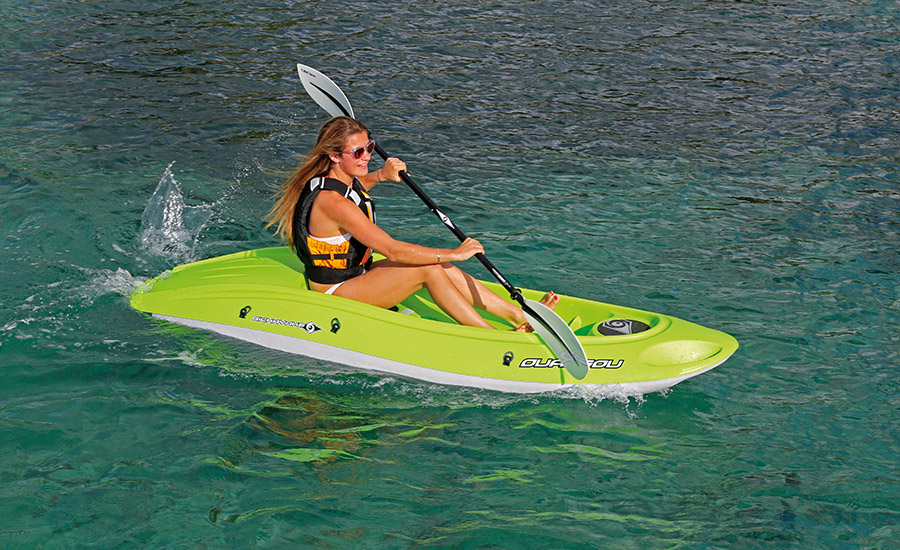Every year design becomes more important as companies strive to produce products that perform flawlessly while remaining aesthetically pleasing. In paddlesports design has become equally as important as function and performance- from kayaks to paddles, to the gear we wear. Design not only allows paddlers to customize their gear and look to suit their individual preferences, but it also allows companies to create their own unique look and style that is instantly recognizable.
Bic Sport was perhaps the first company to approach the launch of a sit-on-top kayak line where design was given as much consideration as performance. Coming from sailing and windsurfing, Bic brought new colors and new shapes to make their SOT kayaks as attractive as possible. With the launch of the Bilabo in 2002, which very quickly received a design star award, Bic changed our expectations for how products should look.
The Bilbao was created using a team of designers to make it float but also be distinctive and look enticing to paddle. The result still influences the market today: “Design was a very important element in defining and launching BIC Kayak in the early 2000s,” says Benoit Treguilly, the Marketing Director for Bic Sport. “It allowed us to differentiate from our main competitors and show that our kayaks were innovative, efficient and aesthetically pleasing.”
Pleasing to the eye is becoming an increasingly important component to success, recognizes American gear mogul NRS. “Design becomes a more important part of the NRS R&D process with every passing year,” says Marketing Director Mark Demming. “Back in the day, our customers simply wanted gear that was durable, functional and reliable. But today’s enthusiasts demand equipment and apparel that performs flawlessly and enhances their experiences on the water.” NRS’ goal is to create products that deliver both the technical sophistication and visual appeal, and achieving that “starts with design.”
An increase of women in paddlesports could potentially be part of the current focus on design. “It’s been great to see the emergence of a strong women’s culture in paddlesports, and to see the industry respond with more women’s-specific gear,” says Demming. “Incorporating women’s perspectives in design has helped drive a movement toward products that are not only tough and functional, but that look and feel good too.”
Palm Equipment, begun by Andy Knight in Somerset England, utilizes bright colors for both their men’s and women’s kit. Palm specializes in making women-specific designs for almost every model of technical apparel they make. Their women’s specific items are often offered in, but not limited to, girlier shades of pink and purple and feature fits that flatter while remaining functional.
Swedish company Melker Sea Kayaks has taken the Bic model to heart, working to create sleek and stylish kayaks in a sustainable way. “Design is in everything we make,” says founder Pelle Stafshede, “but it’s also between those things. It’s a mix of craftmanship, science, innovation, sustainability, storytelling, and philosophy.” Melker’s boats, some of which are made from partly from bamboo, try to emphasize their materials though styling and design. Their boats, which have been nominated for multiple design awards, feature playful colors and distinctive bamboo panels.
Indiana SUP now complements their distinctive monochromatic board designs with special limited versions that are colorful and cheeky, aimed at “paddlers who have missed color” in their other models.
Werner and Aquabound are among paddle companies that have begun offering a wide range of graphics on their blades, with fun, brightly-colored designs inspired by original artwork. Aquabound’s wesbite promotes “eye-popping colors” that “will complement virtually any board.” Each of Werner’s fiberglass whitewater blade designs comes in a specific color, making them easy to identify. While their blade shapes may not change dramatically, most years Werner offers new or special colors to keep things current and interesting.
However, it is important to remember that design cannot replace function and performance. The hard truth is that even if a product looks good, if it doesn’t feel good or perform well, it is unlikely to achieve success. It is clear that people want to look good in order to enjoy paddling, and companies must plan to accommodate for it.
By: Anna Bruno, Kayak Session, Paddle World and Sup World Mag editor


